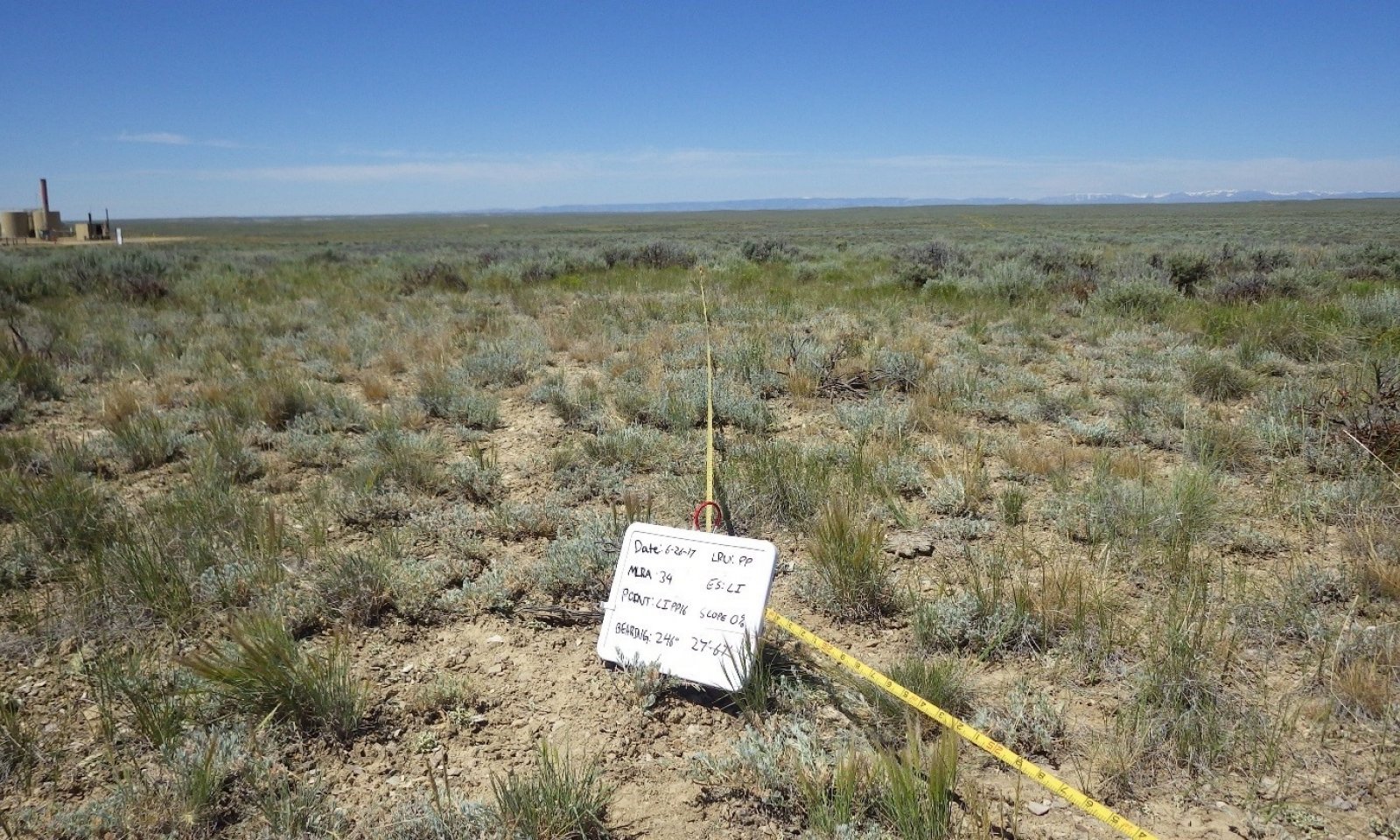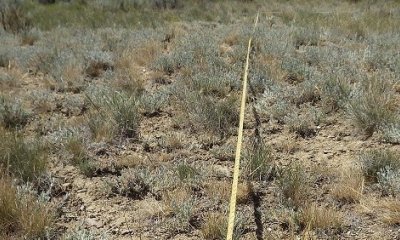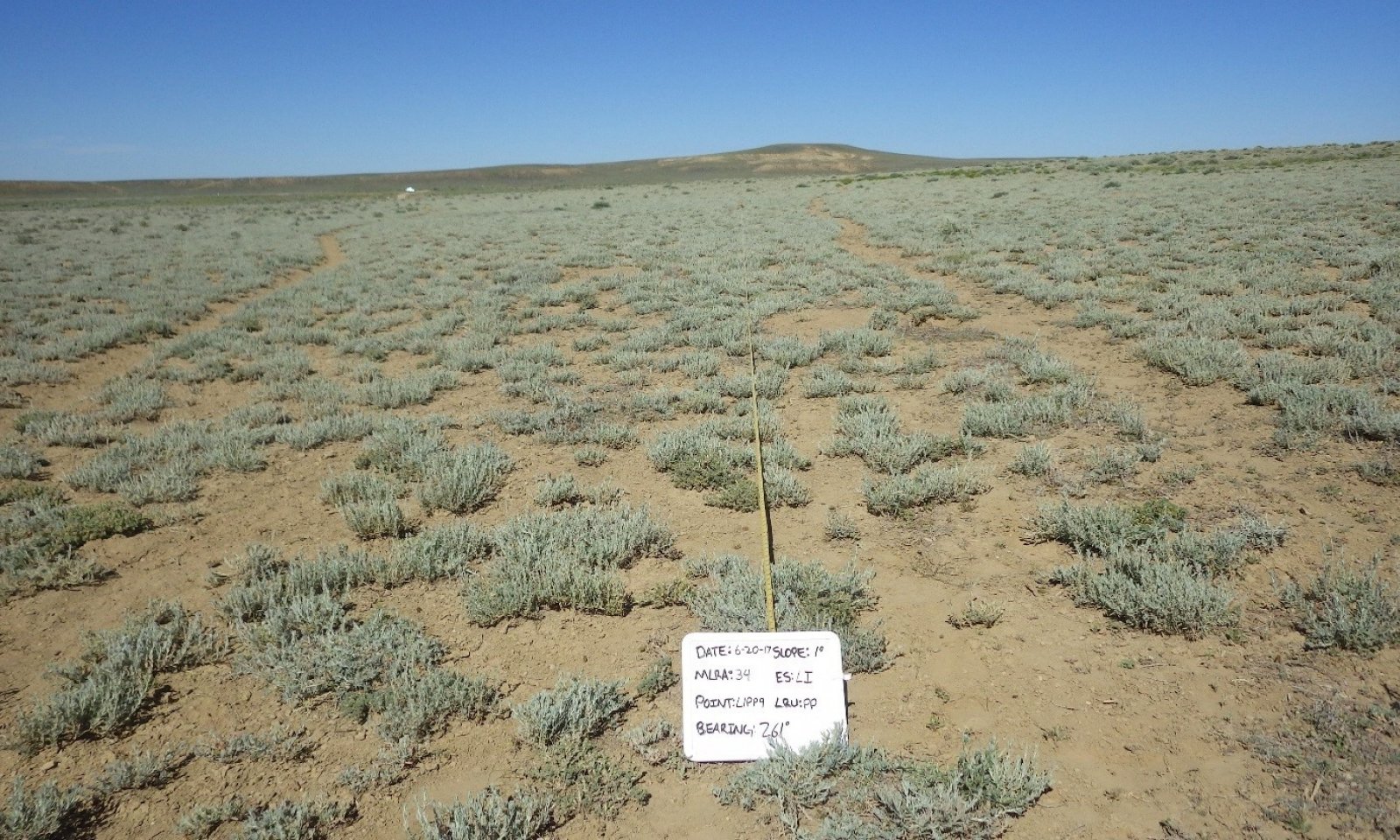
Limy Pinedale Plateau (Li PP)
Scenario model
Current ecosystem state
Select a state
Management practices/drivers
Select a transition or restoration pathway
- Transition T1A More details
- Transition T1B More details
- Restoration pathway R2A More details
- Transition T2A More details
- Transition T2B More details
- Restoration pathway R3A More details
- Transition T3A More details
-
No transition or restoration pathway between the selected states has been described
Target ecosystem state
Select a state
Description
The Winterfat (Heavy Browse) Plant Community (2.1) is characterized by browsed winterfat, high bare ground and an herbaceous component dominated by thickspike wheatgrass and Sandberg bluegrass, with limited mid-stature bunchgrasses. Once mid stature bunchgrasses become scarce, it is unlikely there will be sufficient reproductive capability (seed source, tillering, or resprouting) to recover dominance in a reasonable time frame without extra energy being added to the system. The plant community is highly resistant to changes in composition, due to the dominance and competition of established grazing resistant species. However, the community can be restored to the Reference State over time with decreased herbivory, possibly seeding, and time.
Winterfat dominates with cover as high as 25% or higher. The dominant shrub/subshrub is Winterfat.
Production potential is lower than in Reference State (1), and is somewhat variable, fluctuating in response to drought and wet cycles. Lower soil organic matter content leads to lower soil stability than in the Reference State. Ground cover is reduced. Infiltration is lower than in the Reference State and the water cycle has reduced function due to decreased soil organic matter.
Submodel
Description
This state contains one community, the Salt-Desert Shrub Community (3.1). It is characterized by sparse herbaceous plant cover dominated by salt desert shrubs and bare ground.
Communities in the Disturbed State (3) have crossed a threshold because of soil erosion, loss of soil fertility, and/or degradation of soil properties. Soil erosion affects the hydrology, soil chemistry, soil microorganisms, and soil physics to the point where intensive restoration is required to restore the site to another state or community. Simply changing grazing management may not create sufficient change to restore the site within a reasonable period. It will require a considerable input of energy to move the site back to the Reference State (1).
The Disturbed State (3) is at risk of weed invasion due to the high percentage of bare ground, but climatic conditions contribute to higher resistance to invasion.
Submodel
Mechanism
Increased herbivory (concentrated winter)
The drivers for transition from the Reference State to the Grazed/Browsed State are high intensity grazing (herbivory during spring/summer and/or browse during fall/winter) and/or severe drought.
High rates of herbivory during spring/summer and/or drought can lead to a decline in palatable mid-stature bunchgrasses, mainly Indian ricegrass, a short-lived perennial that requires more frequent seed production to provide an adequate seedbank, and bottlebrush squirreltail, widely adapted to a wide range of ecological conditions (USDA, NRCS, 2018).As bunchgrasses diminish or die during periods of stress, low-stature bunchgrasses and rhizomatous grasses gain a competitive advantage, creating a shift in species composition towards less productive, shorter species. While bare ground may not change, the pattern of bare ground will shift to larger gaps in the canopy and fewer herbaceous plants between shrubs.
Once mid-stature bunchgrasses species become scarce, it is unlikely that they have sufficient reproductive capability (seed source, tillering, or resprouting) to recover dominance in a reasonable time frame without management changes and extra energy being added to the system. When the understory vegetation has been degraded to this point, the transition to the Grazing/Browsed State (2) can occur from the Bunchgrass/Winterfat Plant Community (1.1). The transition is not dependent on the increase of shrub cover, but rather the lack of mid-stature bunchgrasses in the canopy interspaces.
High rates of browse during fall/winter can lead to a decline in winterfat and an increase in bare ground. Often times this occurs at the same time as high levels of use in spring/summer associated with areas that have high wild horse use. Managing wild horse populations is critical to the heath of this site as it is highly preferred by this species.
Management should focus on grazing management strategies that will prevent further degradation. This can be achieved through a grazing management scheme that is within the carrying capacity and varies the season of use to provide periodic deferment during the critical growth period (roughly May-June). Forage quantity and/or quality in the Grazing/Browsed State (2) may be substantially reduced compared to the Reference State, and will dramatically fluctuate in the dry vs. wet years.
Mechanism
Soil disturbing activity (hoof action, anthropogenic activity, rodent activity)
The driver for transition from the Reference State to the Disturbed State is a soil disturbing activity (hoof action, anthropogenic, rodent, etc.). Drought can accelerate this transition.
In some instances, dissolved salts occur below the plant rooting zone, and with soil disturbance these salts are released and made available to plants. With the increase in salts, such as sodium, the plant community can be highly altered. When this happens, a threshold has been crossed and is extremely difficult to remedy.
Indicators of this transition include significant declines in herbaceous cover and an increase in salt loving plants such as Gardner’s saltbush (Atriplex gardneri). The trigger for this transition is a loss of “A” horizon material and an increase in dissolved salts, released from a deeper “B” horizon. Soil erosion is accompanied by decreased soil fertility driving the transitions to the Disturbed State. Several other key factors signal the approach of a threshold: an increase in soil dispersion (caused by increased sodium), a decrease in soil surface aggregate stability, and/or evidence of erosion, including water flow patterns, development of plant pedestals, and litter movement.
Mechanism
Decreased herbivory (prescribed grazing practices), seeding time
The drivers for this restoration pathway are restoration of native herbaceous species by grazing rest or deferment followed by changing the season of use from spring to fall, lowering stocking density, possible seeding of native herbaceous species, and time. If some mid-stature bunchgrasses remain in the understory, proper grazing management can move the site back to the Reference State (1). This could take multiple generations of management or could be accelerated with rest or deferment combined with successive wet springs conducive to seed germination and seedling establishment. (Derner, Schuman, Follett, & Vance, 2014).
Mechanism
Soil disturbing activity (hoof activity, anthropogenic activity)
The driver for transition from the Grazed/Browsed State to the Disturbed State (T2A) is an increase in salt-desert shrubs, caused by soil disturbance that frees up exchangeable sodium and other salts that occur with the subsurface soil horizons. Examples of soil disturbance include hoof action, recreation, small burrowing mammals, and high stocking densities.
If depth to sodium affected subsurface soil horizon (>8mmhos/cm) is relatively shallow (<10cm), the risk of crossing this threshold increases. When this threshold is crossed, plant community dynamics are affected, bare ground increases, hydrology is changed due to the restrictive nature of the exchangeable sodium and runoff is increased. In these cases it may be impossible to recover from this threshold.
Indicators of the Disturbed state are an increase in salt desert shrubs, such as; Gardner’s saltbush (Atriplex gardneri) and spiny horsebrush (Tetradymia spinescens), and increased bare ground.
Mechanism
The driver for transition from the Grazed/Browed to the Highly Disturbed State (T2B) is a topsoil removing event with mechanical equipment. Examples include construction sites, oil and gas activity, and borrow areas.
Mechanism
If soil disturbance is minimal, Decreased herbivory (prescribed grazing practices), seeding time
The drivers for this restoration pathway are decreased herbivory/browse, seeding and time, if soil disturbance has not completely altered to soil chemistry of the site (i.e. exposing the soil layer with exchangeable sodium and other salts). Due to loss of soil fertility, structure, and organic matter, reference community plants are slow to repopulate the site. Success of this restoration is highly dependent upon climatic factors such as drought.
Model keys
Briefcase
Add ecological sites and Major Land Resource Areas to your briefcase by clicking on the briefcase (![]() ) icon wherever it occurs. Drag and drop items to reorder. Cookies are used to store briefcase items between browsing sessions. Because of this, the number of items that can be added to your briefcase is limited, and briefcase items added on one device and browser cannot be accessed from another device or browser. Users who do not wish to place cookies on their devices should not use the briefcase tool. Briefcase cookies serve no other purpose than described here and are deleted whenever browsing history is cleared.
) icon wherever it occurs. Drag and drop items to reorder. Cookies are used to store briefcase items between browsing sessions. Because of this, the number of items that can be added to your briefcase is limited, and briefcase items added on one device and browser cannot be accessed from another device or browser. Users who do not wish to place cookies on their devices should not use the briefcase tool. Briefcase cookies serve no other purpose than described here and are deleted whenever browsing history is cleared.
Ecological sites
Major Land Resource Areas
The Ecosystem Dynamics Interpretive Tool is an information system framework developed by the USDA-ARS Jornada Experimental Range, USDA Natural Resources Conservation Service, and New Mexico State University.






